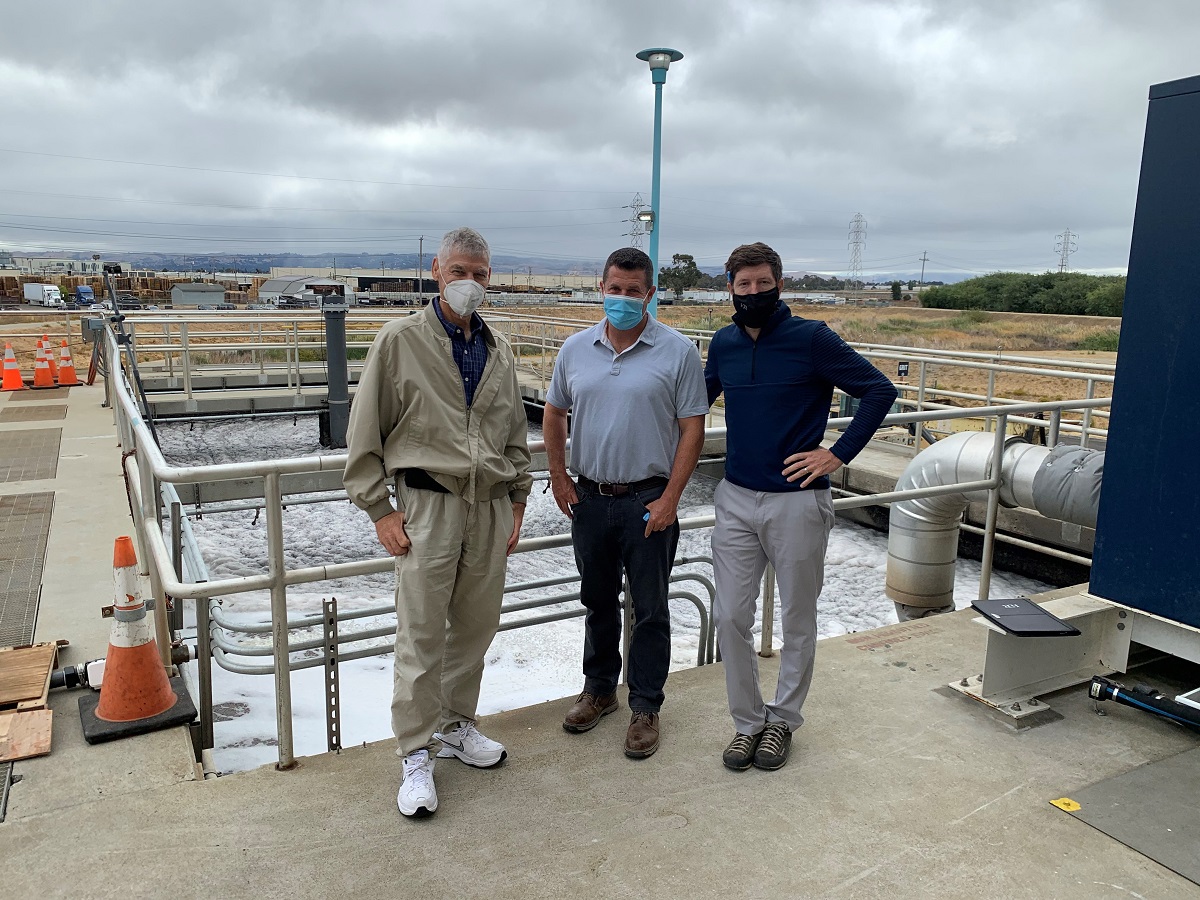
Oro Loma Sanitary District
Join this session at AC23 in San Diego, April 18-21
Mike Falk, PE, and Jimmy Dang, PE, will present a paper at the Annual Conference on an innovative sidestream process demonstrated at the Oro Loma Sanitary District, where Dang is the general manager.
The process removes ammonia using Microvi’s MNE technology, a new process that employs synthetic composites called “biocatalysts,” which contain a high density of specific organisms capable—in this case—of oxidizing high levels of ammonia and converting it to nitrite/nitrate. It is the first implementation of the technology in the Western U.S.
Falk says the demonstration project is a “low-hanging fruit” approach to nutrient management since the sidestream is warm and concentrated (about 20% of the effluent nitrogen load), resulting in favorable kinetics. Furthermore, the treatment system is relatively easy to construct and sequence as a stand-alone process. Since its start up in April 2021, the process has performed well.
Falk is a Senior Professional Associate at HDR, where he has worked since 2008.
He received BS and MS degrees in civil and environmental engineering from Virginia Tech and U-Mass Amherst, respectively, followed by a Ph.D. from UC Davis.
As an undergraduate, Falk says, he was inspired by Professor Marc Edwards, the academic who cracked the Flint, MI, drinking water crisis. “Marc understood the mechanics behind the issue,” says Falk. “He pointed me toward U-Mass Amherst, as he knew I was interested in biological treatment.”
After that, Falk decided to head west and learn about the application of molecular biology to wastewater treatment at Davis. Following graduate school, he met another mentor, J.B. Neethling of HDR, who had led research efforts in nutrient management and convinced him to give consulting a try.
Falk says he is proudest of the Bay Area nutrient strategy led by the Bay Area Clean Water Agencies (BACWA). “It’s by far the most impactful effort that I have worked on,” he says. His firm is involved, along with treatment plants, scientists, regulators, NGOs, and others—all striving to develop a framework for making informed decisions about how to best navigate nutrient management.
“The EPA routinely references the Bay Area nutrient management program as the blueprint for how to develop a collaborative nutrient strategy,” Falk says.
He says the most enjoyable aspect of his work is navigating the prioritization of projects.
“Our clients face so many competing interests with limited funding,” he says. “In order to prioritize such funds, collaborative workshops are essential for making informed and defensible decisions. Rolling up our sleeves during such a process with our clients is the most enjoyable part of the job.”
As GM, Dang is responsible for a staff of 46 highly trained professionals and a facility rated at 20 mgd, serving more than 180,000 customers.
He is a licensed Civil Engineer in the state of California. He holds a BS degree in civil engineering from Cal Poly San Luis Obispo and an MS degree in public administration from CSU Dominguez Hills.
Of his 18 years of experience in both public and private sectors, he says he is most proud of the people he works with. “The staff here at the district are extremely talented and just know how to get the job done,” he says. “When we all put our minds to the task at hand, I have no doubt that we will figure it out and make it happen.”
Dang says he enjoys the challenge of solving problems.
“As an engineer at heart, it is a passion of mine to try to help resolve issues that we all face,” he says. “Whether it is technical, personnel, or project related, it excites me to know that I can be of value when someone approaches me with an issue they need help resolving.”
In his view, industry-wide challenges include reducing nutrients sent to the Bay, a long-term solution for biosolids handling, and becoming an overall energy producer rather than a consumer.
Regarding the sidestream project, he believes the work at Oro Loma has helped inform the industry on what technology can do when you simply try it out.
“We took a fairly conservative approach by starting at a very small bench scale level, then converting to a medium-sized pilot, and now a full-scale demonstration,” he said. “Partnering with technology companies not only helps further research, but with funding help from the EPA and the support from our Board of Directors, we were happy to help Microvi with performing research and operating their technology.
“It makes me feel great about contributing to science in a very economical way.”
In their “Hot Topic” presentation, Falk and Dang will discuss the operation of the sidestream technology since April 2021 and will include data through 2022—more than a year.
“The MNE biocatalysts acclimated to the feed water (OLSD’s dewatering filtrate) as evidenced by signs of nitrification within the first week of start-up,” they report.
“The commissioning process and initial months of operation found that the technology was robust and able to achieve treatment objectives under steady-state conditions.
“The audience will leave this presentation with an understanding of i) what is the side stream and why is it attractive for nutrient management, ii) what is an MNE biocatalyst and why it might be attractive for nutrient management, and iii) actual data to support the technology claims,” they summarized.
To view a video of the process, go to bit.ly/3PnurhT.